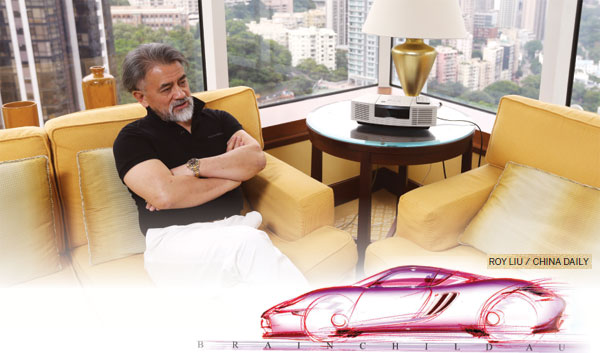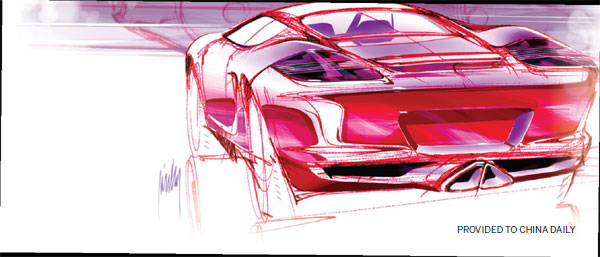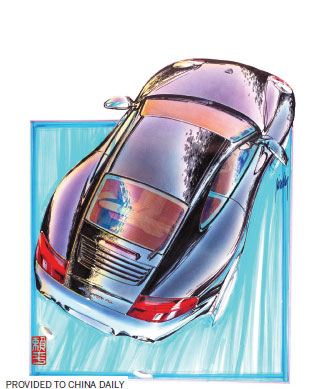A life along classic lines
Updated: 2014-11-10 09:05
By Ming Yeung(HK Edition)
|
|||||||||




Pinky Lai went from floating ice cream stick rafts in the gutters of rain-drenched Hong Kong to being anointed the chief designer of Porsche. Ming Yeung meets the man who believes in investing his designs with emotion.
Pinky Lai always knows he is special. Being of a rebellious and discontented nature, he is perennially on the lookout for newer things to do.
He was one of the masterminds who helped bring Porsche - the internationally-exalted German sports car manufacturer - back on their feet after the dramatic downturn in the early 1990s. He retired in April this year as chief of exterior design for the company.
At 63, Lai appears relaxed and fit in his black polo shirt and white trousers. He has the bearing of a much younger man, creating a stark contrast with his silver-grey hair. You could say, he stands out in a crowd.
Lai grew up in a middle-class family in the 1960s, when most people in Hong Kong were poor.
"During the days of continuous rain, we collected ice cream sticks and tied them up together with rubber bands to make rafts, and then played with them in the rain gutters. We built small ones to bigger ones. We were so proud of ourselves," Lai laughs, losing himself in fond memories of his youth.
Although he showed a talent for designing toys, Lai was no scholar. After he graduated from secondary school, his father suggested he take an apprenticeship at the Tai Koo dockyard. He went along with it and spent two years there. Looking back on those days, he believes it was the responsibilities he shouldered then that gave him the toughness and determination to face new challenges throughout his career, working with world-class companies.
"I have been fearless when confronted with new material, having to learn different skills. Every six months there was a new challenge, new material, new knowledge. It was kind of a gut character that became an advantage in my career later on," Lai recalls.
Lai was satisfied with his two years at Tai Koo but didn't want to make a career of it. His father was disappointed when he quit.
"I ended up in a backstreet metal shop cutting metals, grinding metals, greasy and heavy, sometimes dangerous," he says. The job didn't last a week. He went to work at a textile company in the New Territories. The air was stuffy and choking with cotton fibers. He lasted not even a month.
He felt happy when he found a draftsman's job at the Hong Kong Telephone Company with office in Prince's Building. Strolling on a street in Central one day, Lai saw a recruitment notice posted by Jens Munk, a Danish decoration company looking for an interior design trainee. He checked it out.
Lai got the job, which helped him expand his perception and broaden his sense of aesthetics.
After a clash with his parents Lai wanted to get away from the smog, noise and the crowds. He moved to Lamma Island and befriended a group of hipster graduates from the University of Hong Kong's school of architecture.
He was swept up in the dreams of his university friends, who declared their intentions to travel around the world before settling down. "I was inspired to follow them," Lai tells China Daily. "I was not happy with myself. I thought I had really made a mess of things. I thought, 'how come I am slow and not as smart as other kids?'"
With his sense of utter failure compounded by his parents' disappointment, Lai decided it was time to get out - to leave Hong Kong and start all over. "If you don't see beyond the fence, you think the world is only this big."
At 21, he bought a one-way ticket to Rome, where he was admitted to Istituto Superiore per le Industrie Artistiche to study industrial design. He got a part-time job in a Chinese restaurant and didn't contact his family much.
One day at work, he got a phone call. His father had died. "I was kind of sad. I got a ticket to go home," he said.
Back to school
During the six years studying in Rome, Lai went to Germany to work at summer jobs every year. He thought he would like to work there after graduation.
The world was not waiting with open arms. He sent out 30 applications. Only Ford Motor Company invited him to an interview. A week later, a package arrived from Ford, including an air ticket and a school registration form, to the Royal College of Art in London, where he was offered a two-year scholarship to specialize in the post-graduate transportation design.
"I was frustrated because I just got out of school and they wanted to send me back to school," he says. Still, Lai managed to find contentment and pressed on, believing he had found a direction in life, at last.
Had his father lived, he would have seen the many accomplishments of the son who had disappointed him. His mother did share his success, as he moved from Ford to BMW and to Porsche.
He won a slew of awards for his designs for the 911 Turbo and Carrera models between 1997 and 2003, including five from Italy's L'Automobile Piu Bella Del Mondo (the World's Most Beautiful Automobiles) and one from the German Design Council.
Lai says automobile designers live in a "bubble": they consider themselves "superior" to fashion designers and designers of consumer goods - because of the amount of investment entailed. But, he adds, the automotive designers love every minute of their work.
"If you work for Porsche, you don't even call it work anymore. It's enjoyment, pure joy. Even when you work 12 hours a day, and come out totally exhausted, you still like it because you know you're working on a dream car and one day, you'll be driving it yourself," Lai says animatedly.
Indeed he designed a number of cars that many people dream of owning. Over the past 26 years at Porsche, he worked on the Boxster, Cayman and the 996 overhaul of the legendary 911. But the process of design that he describes is always a lonesome journey.
"Design is never team work, especially in the initial stage. The company looks for certain distinction, like handwriting. Only when you have something written up, a certain style is created. It becomes team work when it spreads out to different specialists," Lai explains.
After being assigned a new project, Lai would take some time to meditate in the green surroundings of his office. "You start dreaming but in fact it's not a dream. It's sort of mental designing, at the end of the day. I already had a Polaroid picture in my brain. This is visualization of design before you sketch," Lai says.
Very often he would do meditative jogging, for hours, in the forest to help him think through design problems he encountered during the day. "Before I start sketching, or even before I start thinking through designing the lines, curves or surface, I start putting together a 'shopping list' of design features and elements," he says. "A shopping list is my guideline to help me focus on my design."
It's a road show
"Drama" is the distinguishing characteristic of Lai's designs. They arouse emotions in whoever looks at them. "To see the emotion you have to turn on all the lights to see the design clearly. To look at the drama aspects of your design, you have to turn off the light gradually. The car will start to show where the drama is."
Having worked tirelessly for prestigious carmakers, retirement for Lai felt like a "death sentence". He received a very good offer of semi-retirement starting at the end of 2011, with his official retirement commencing in April this year.
Still, he's not ready to quit. He wants to make a contribution to his homeland. And he's glad to call Hong Kong his second-home. He still finds his roots here, even after four decades in Europe. He recently co-founded an automobile company in which he is the co-CEO and Chief Creative Officer.
China, he concedes, is still lacking "design identity". "China is overflowing with foreign designers but it is not going anywhere for some reason," he adds. "You can buy technologies, but not design - just like culture of a nation, how much could you expect from all these Western designers understand and care about the Chinese culture of thousands of years?"
But Lai is confident about the automobile industry taking off in China. Being a "half foreigner", feels Lai, is an advantage - a chance to apply his Western experience to designing for China. His goal is to design "an attractive environment-friendly car with a genuine new Chinese brand".
Contact the writer at mingyeung@chinadailyhk.com
(HK Edition 11/10/2014 page8)